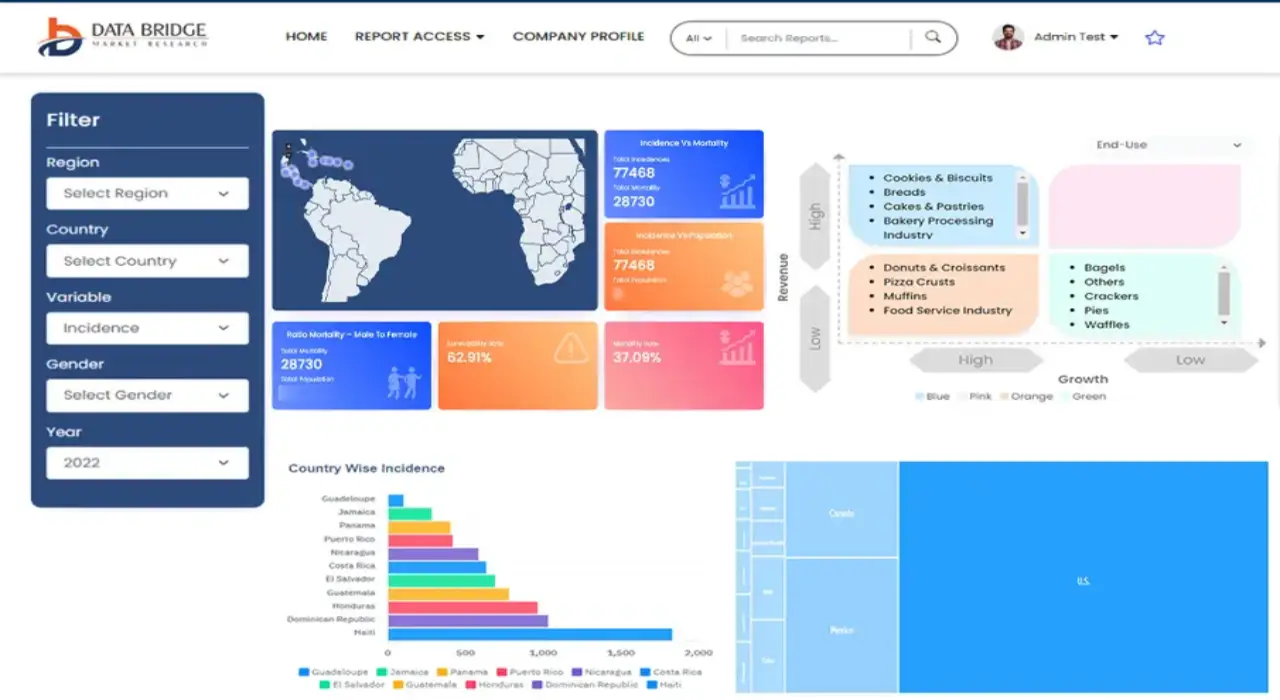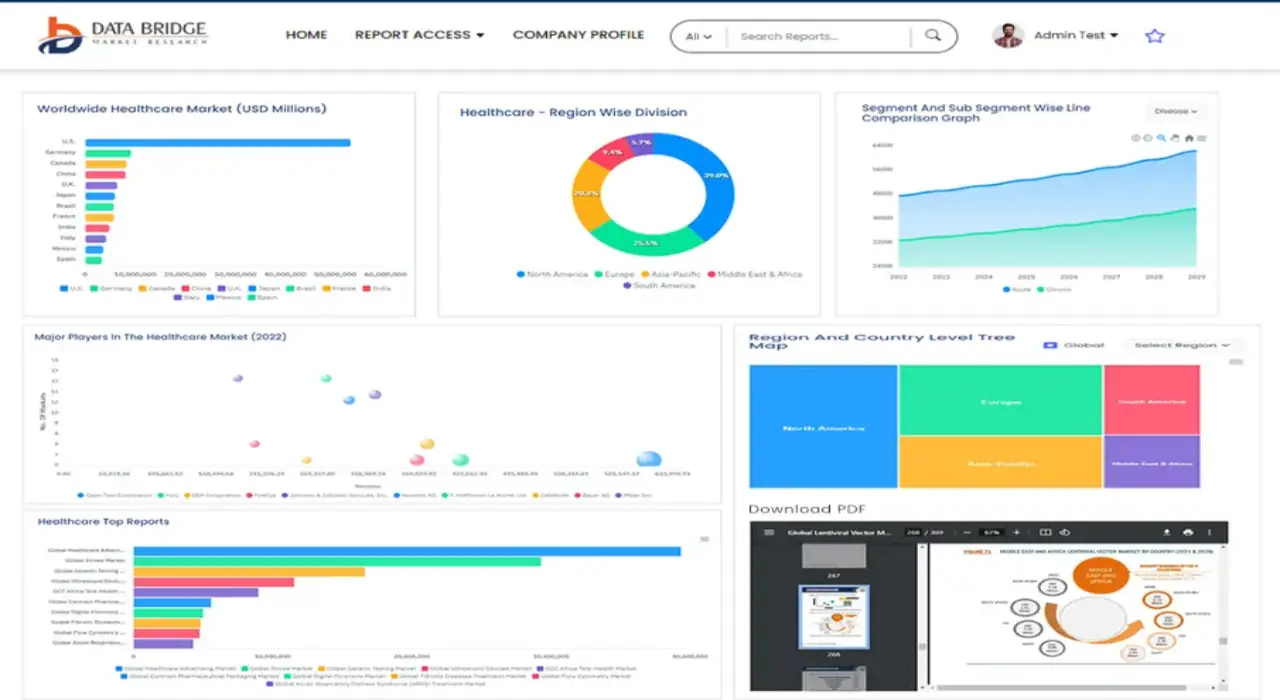>Global Artificial Intelligence (AI) Governance Market, By Component (Solutions, Services), Technology (Computer Vision, Machine Learning, Natural Language Processing, Others), Function (Training, Inference), Deployment Type (On-Premises, Cloud, Hybrid), Vertical (BFSI, Healthcare and Life Sciences, Government and Defence, Media and Entertainment, Telecom, Retail, Automotive, Others) – Industry Trends and Forecast to 2029
Artificial Intelligence (AI) Governance Market Analysis and Size
Various industries can use AI governance to develop online and offline capabilities such as real-time offer management, automated checkout systems, and improved behaviour analytics. The demand for AI governance from data science applications has also increased significantly in recent years, owing to its use in data governance, process optimization, training, and other areas.
Data Bridge Market Research analyses that the artificial intelligence (AI) governance market which was growing at a value of 564.3 million in 2021 and is expected to reach the value of USD 25,857.41 million by 2029, at a CAGR of 61.30% during the forecast period of 2022-2029. The market report curated by the Data Bridge Market Research team includes in-depth expert analysis, import/export analysis, pricing analysis, production consumption analysis, and pestle analysis.
Report Scope and Market Segmentation
|
Report Metric |
Details |
|
Forecast Period |
2022 to 2029 |
|
Base Year |
2021 |
|
Historic Years |
2020 (Customizable to 2014 - 2019) |
|
Quantitative Units |
Revenue in USD Million, Volumes in Units, Pricing in USD |
|
Segments Covered |
Component (Solutions, Services), Technology (Computer Vision, Machine Learning, Natural Language Processing, Others), Function (Training, Inference) Deployment Type (On-Premises, Cloud, Hybrid), Vertical (BFSI, Healthcare and Life Sciences, Government and Defence, Media and Entertainment, Telecom, Retail, Automotive, Others) |
|
Countries Covered |
U.S., Canada and Mexico in North America, Germany, France, U.K., Netherlands, Switzerland, Belgium, Russia, Italy, Spain, Turkey, Rest of Europe in Europe, China, Japan, India, South Korea, Singapore, Malaysia, Australia, Thailand, Indonesia, Philippines, Rest of Asia-Pacific (APAC) in the Asia-Pacific (APAC), Saudi Arabia, U.A.E, South Africa, Egypt, Israel, Rest of Middle East and Africa (MEA) as a part of Middle East and Africa (MEA), Brazil, Argentina and Rest of South America as part of South America |
|
Market Players Covered |
IBM Corporation (U.S.), Microsoft (U.S.), Siemens AG (Germany), ANSYS, Inc (U.S.), SAP SE (Germany), Oracle (U.S.), Robert Bosch GmbH (Germany), Swim.ai, Inc. (U.S.)., Atos S.E. (France), ABB (Switzerland), KELLTON TECH (India), AVEVA Group plc (U.K.), DXC Technology Company (U.S.), Altair Engineering, Inc (U.S.), Hexaware Technologies Limited (India), Tata Consultancy Services Limited (India), Infosys Limited (Bengaluru), NTT DATA, Inc. (Japan), TIBCO Software Inc. (U.S.) |
|
Opportunities |
|
Market Definition
Artificial intelligence (AI) governance is the idea that a legal framework should be in place to ensure that machine learning (ML) techniques are thoroughly researched and developed in order for mankind to operate in a reasonable manner through the use of AI systems. Artificial intelligence (AI) governance seeks to bridge the gap between technological advancement and accountability by addressing issues such as notification rights and potential violations.
Global Artificial Intelligence (AI) Governance Market Dynamics
Drivers
- The growing need for transparency and trust building in AI technologies
The increasing need for building trust in AI systems and rising demand for transparency in AI decisions around the world is driving the AI Governance market. AI governance vendors are more focused on advancements in AI, cloud solutions and services by incorporating machine learning algorithms and deep learning frameworks. Such major factors are propelling the AI governance market forward. The AI governance market is expanding due to the continuous development and implementation of AI governance solutions to identify the most effective way to achieve business goals.
- Easy access to historical datasets and convenience of data storage
The availability of historical datasets is a critical factor driving the rate of AI innovation. Now that data storage and recovery are more affordable, healthcare institutions and government agencies are producing unstructured data that is accessible to the research domain. Large datasets ranging from historical rainfall trends to clinical imaging are now available to researchers. Next-generation computing architectures enable information scientists and researchers to innovate more quickly by providing access to large datasets. Furthermore, advances in deep learning and ANN (Artificial Neural Networks) have accelerated AI adoption across a wide range of industries, including aerospace, healthcare, manufacturing, and automotive.
Opportunity
Increased compliance with technology regulations will boost market growth. Furthermore, the use of artificial intelligence to reduce gender bias and discrimination will increase the beneficial opportunities for the growth of the artificial intelligence (AI) governance market.
Restraints
However, the establishment of comprehensive ethical principles for artificial intelligence and the high cost of investment will impede the growth of the artificial intelligence (AI) governance market. In addition, a lack of artificial intelligence expertise and skills will impede the growth of the artificial intelligence (AI) governance market.
This artificial intelligence (AI) governance market report provides details of new recent developments, trade regulations, import-export analysis, production analysis, value chain optimization, market share, impact of domestic and localized market players, analyses opportunities in terms of emerging revenue pockets, changes in market regulations, strategic market growth analysis, market size, category market growths, application niches and dominance, product approvals, product launches, geographic expansions, technological innovations in the market. To gain more info on the artificial intelligence (AI) governance market contact Data Bridge Market Research for an Analyst Brief, our team will help you take an informed market decision to achieve market growth.
COVID-19 Impact on Artificial Intelligence (AI) Governance Market
Remote working presents productivity challenges as well as new security risks during the COVID-19 crisis. To combat and anticipate the new COVID-19 crises, various industries such as healthcare, automotive, and others require the assistance of advanced technologies such as Internet of Things (IoT), Artificial Intelligence (AI), Big Data, and Analytics. Healthcare sectors desperately need decision-making technologies to handle the COVID-19 virus and provide appropriate recommendations in real-time to prevent its spread. AI is one such technology that can easily track the spread of the COVID-19 virus, identify high-risk patients, and aid in real-time infection control. As a result, the AI governance market is expected to grow 2.5X from 2019 to 2020, with a surge in demand during the COVID-19 outbreak, as increasing adoption in the healthcare industry becomes the new norm. Furthermore, the overall AI governance market is expected to grow at a rapid pace beginning in Q1 2021.
Recent Development
- In February 2022, Meta AI (formerly Facebook AI) announced that it had open-sourced data2vec, a unified framework for self-supervised deep learning on text, images, and speech audio data.
- In February 2022, Virtana, a California-based technology company, announced that it had developed a hybrid cloud management solutions platform that would allow its customers to plan, execute, and manage their hybrid cloud implementations. In addition, the company stated that it used a combination of AI, machine learning, and data analytics to provide observability for managing app workloads across public, private, hybrid, and multi-cloud environments.
Global Artificial Intelligence (AI) Governance Market Scope
The artificial intelligence (AI) governance market is segmented on the basis of component, technology, function, deployment type and vertical. The growth amongst these segments will help you analyse meagre growth segments in the industries and provide the users with a valuable market overview and market insights to help them make strategic decisions for identifying core market applications.
Component
- Solution
- Platform
- Software tools
- Services
- Consulting
- Integration
- Support and maintenance
Technology
- Computer Vision
- Machine Learning
- Natural Language Processing
- Others
Function
- Training
- Inference
Deployment type
- On-Premises
- Cloud
- Hybrid
Vertical
- BFSI
- Healthcare and Life Sciences
- Government and Defence
- Media and Entertainment
- Telecom
- Retail
- Automotive
- Others
Artificial Intelligence (AI) Governance Market Regional Analysis/Insights
The artificial intelligence (AI) governance market is analysed and market size insights and trends are provided by country, component, technology, function, deployment type and vertical as referenced above.
The countries covered in the artificial intelligence (AI) governance market report are U.S., Canada and Mexico in North America, Germany, France, U.K., Netherlands, Switzerland, Belgium, Russia, Italy, Spain, Turkey, Rest of Europe in Europe, China, Japan, India, South Korea, Singapore, Malaysia, Australia, Thailand, Indonesia, Philippines, Rest of Asia-Pacific (APAC) in the Asia-Pacific (APAC), Saudi Arabia, U.A.E, South Africa, Egypt, Israel, Rest of Middle East and Africa (MEA) as a part of Middle East and Africa (MEA), Brazil, Argentina and Rest of South America as part of South America.
Europe is expected to grow at the fastest rate during the forecast period due to the various developments occurring in the European region as a result of AI governance. The region's adoption of AI-powered services is expected to grow as a result of the growing ethical issues surrounding AI technology and the growing need to create a legal framework to ensure that the ML algorithm is developed for the good of humanity.
The country section of the report also provides individual market impacting factors and changes in market regulation that impact the current and future trends of the market. Data points like down-stream and upstream value chain analysis, technical trends and porter's five forces analysis, case studies are some of the pointers used to forecast the market scenario for individual countries. Also, the presence and availability of Global brands and their challenges faced due to large or scarce competition from local and domestic brands, impact of domestic tariffs and trade routes are considered while providing forecast analysis of the country data.
Competitive Landscape and Artificial Intelligence (AI) Governance Market Share Analysis
The artificial intelligence (AI) governance market competitive landscape provides details by competitor. Details included are company overview, company financials, revenue generated, market potential, investment in research and development, new market initiatives, Global presence, production sites and facilities, production capacities, company strengths and weaknesses, product launch, product width and breadth, application dominance. The above data points provided are only related to the companies' focus related to artificial intelligence (AI) governance market.
Some of the major players operating in the artificial intelligence (AI) governance market are:
- IBM Corporation (U.S.)
- Microsoft (U.S.)
- Siemens AG (Germany)
- ANSYS, Inc (U.S.)
- SAP SE (Germany)
- Oracle (U.S.)
- Robert Bosch GmbH (Germany)
- Swim.ai, Inc. (U.S.)
- Atos S.E. (France)
- ABB (Switzerland)
- KELLTON TECH (India)
- AVEVA Group plc (U.K.)
- DXC Technology Company (U.S.)
- Altair Engineering, Inc (U.S.)
- Hexaware Technologies Limited (India)
- Tata Consultancy Services Limited (India)
- Infosys Limited (Bengaluru)
- NTT DATA, Inc. (Japan)
- TIBCO Software Inc. (U.S.)
SKU-
Accédez en ligne au rapport sur le premier cloud mondial de veille économique
- Tableau de bord d'analyse de données interactif
- Tableau de bord d'analyse d'entreprise pour les opportunités à fort potentiel de croissance
- Accès d'analyste de recherche pour la personnalisation et les requêtes
- Analyse de la concurrence avec tableau de bord interactif
- Dernières actualités, mises à jour et analyse des tendances
- Exploitez la puissance de l'analyse comparative pour un suivi complet de la concurrence
Méthodologie de recherche
La collecte de données et l'analyse de l'année de base sont effectuées à l'aide de modules de collecte de données avec des échantillons de grande taille. L'étape consiste à obtenir des informations sur le marché ou des données connexes via diverses sources et stratégies. Elle comprend l'examen et la planification à l'avance de toutes les données acquises dans le passé. Elle englobe également l'examen des incohérences d'informations observées dans différentes sources d'informations. Les données de marché sont analysées et estimées à l'aide de modèles statistiques et cohérents de marché. De plus, l'analyse des parts de marché et l'analyse des tendances clés sont les principaux facteurs de succès du rapport de marché. Pour en savoir plus, veuillez demander un appel d'analyste ou déposer votre demande.
La méthodologie de recherche clé utilisée par l'équipe de recherche DBMR est la triangulation des données qui implique l'exploration de données, l'analyse de l'impact des variables de données sur le marché et la validation primaire (expert du secteur). Les modèles de données incluent la grille de positionnement des fournisseurs, l'analyse de la chronologie du marché, l'aperçu et le guide du marché, la grille de positionnement des entreprises, l'analyse des brevets, l'analyse des prix, l'analyse des parts de marché des entreprises, les normes de mesure, l'analyse globale par rapport à l'analyse régionale et des parts des fournisseurs. Pour en savoir plus sur la méthodologie de recherche, envoyez une demande pour parler à nos experts du secteur.
Personnalisation disponible
Data Bridge Market Research est un leader de la recherche formative avancée. Nous sommes fiers de fournir à nos clients existants et nouveaux des données et des analyses qui correspondent à leurs objectifs. Le rapport peut être personnalisé pour inclure une analyse des tendances des prix des marques cibles, une compréhension du marché pour d'autres pays (demandez la liste des pays), des données sur les résultats des essais cliniques, une revue de la littérature, une analyse du marché des produits remis à neuf et de la base de produits. L'analyse du marché des concurrents cibles peut être analysée à partir d'une analyse basée sur la technologie jusqu'à des stratégies de portefeuille de marché. Nous pouvons ajouter autant de concurrents que vous le souhaitez, dans le format et le style de données que vous recherchez. Notre équipe d'analystes peut également vous fournir des données sous forme de fichiers Excel bruts, de tableaux croisés dynamiques (Fact book) ou peut vous aider à créer des présentations à partir des ensembles de données disponibles dans le rapport.















